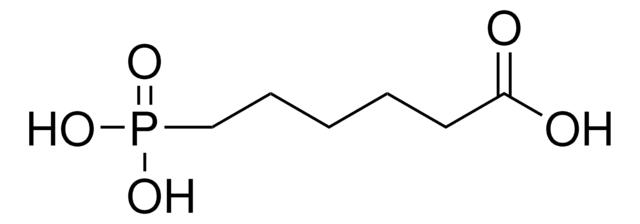96708
Phosphonoacetic acid
TraceCERT®, 31P-qNMR Standard, Manufactured by: Sigma-Aldrich Production GmbH, Switzerland
About This Item
Recommended Products
Quality Level
product line
TraceCERT®
grade
TraceCERT®
form
solid
shelf life
limited shelf life, expiry date on the label
manufacturer/tradename
Manufactured by: Sigma-Aldrich Production GmbH, Switzerland
technique(s)
qNMR: suitable
mp
143-146 °C (lit.)
application(s)
cleaning products
cosmetics
flavors and fragrances
food and beverages
personal care
pharmaceutical
SMILES string
OC(=O)CP(O)(O)=O
InChI
1S/C2H5O5P/c3-2(4)1-8(5,6)7/h1H2,(H,3,4)(H2,5,6,7)
InChI key
XUYJLQHKOGNDPB-UHFFFAOYSA-N
Looking for similar products? Visit Product Comparison Guide
Related Categories
General description
Certified content by quantitative NMR incl. uncertainty and expiry date are given on the certificate.
Download your certificate at: http://www.sigma-aldrich.com.
Check out our entire range of quantitative NMR standards (qNMR standards)
Application
- Enhancing Guide RNA Stability and Editing Yields: Phosphonoacetate modifications have been shown to significantly enhance the stability and editing efficiency of guide RNAs for Cas9-based genome editors. This development has profound implications in genetic engineering and therapeutic applications, where precision and stability are crucial (Ryan et al., 2023).
- Glomerular and Tubulointerstitial Nephropathy Study: Phosphonoacetic acid has been indirectly related to studies on kidney diseases such as glomerular and tubulointerstitial nephropathy, showcasing its potential relevance in medical research to understand and treat complex renal conditions (Pleško et al., 2021).
- Environmental Impact of Phosphonoacetate: Research on PMIDA-modified magnetic nanoparticles, including those related to phosphonoacetate, explores their application in liver MRI, indicating its utility in enhancing diagnostic imaging techniques and its potential environmental implications (Demin et al., 2018).
- CRISPR-Cas Specificity Improvement: Modifications including phosphonoacetate derivatives have been employed to improve the specificity and efficiency of CRISPR-Cas systems in gene editing, underscoring the chemical′s role in cutting-edge biotechnological research (Ryan et al., 2018).
- Cardiovascular Pharmacology: Studies involving phosphonoacetic acid have been connected to cardiovascular pharmacology, particularly in exploring the mechanisms that inhibit calcification in vascular tissues, which is vital for developing treatments for vascular calcification diseases (Duan et al., 2017).
Recommended products
Legal Information
Storage Class Code
11 - Combustible Solids
WGK
WGK 3
Flash Point(F)
Not applicable
Flash Point(C)
Not applicable
Choose from one of the most recent versions:
Already Own This Product?
Find documentation for the products that you have recently purchased in the Document Library.
Customers Also Viewed
Our team of scientists has experience in all areas of research including Life Science, Material Science, Chemical Synthesis, Chromatography, Analytical and many others.
Contact Technical Service













